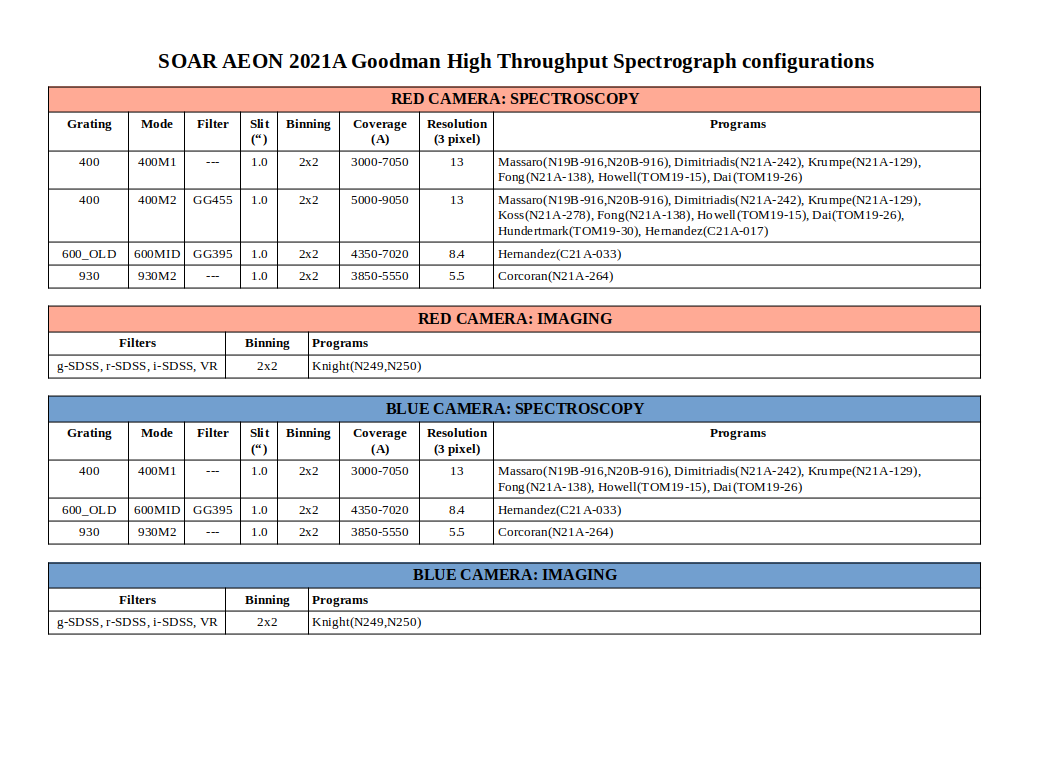AEON Features for 2021A
A total of 25 nights (255h) for 14 programs have been scheduled in AEON-queue mode at SOAR for 2021A.
Goodman BLUE camera will be available for the first time.
We are offering the Goodman BLUE camera in AEON queue mode for a limited number AEON nights in 2021A. Because selecting one or the other detector is a daytime task, this is not an option users can request during the night.
We will schedule the BLUE camera in AEON queue mode 1 night per month during this semester. This means the Goodman BLUE camera will be available 6/25= 24% of the total of AEON time in 2021A, with the RED camera installed the other 76%. We will notify users 1-2 weeks in advance when scheduling a BLUE camera night. The first Goodman BLUE night: Feb 18.
Advantages and caveats for each detector are described in the Goodman Instrument Characteristics page.
Detector noise characteristics for AEON data:
All AEON data are collected using a single fixed readout mode: 344ATTN3 for the RED camera, which corresponds to a readout noise= 3.9 e-, and gain=1.5 e-/ADU, and 200ATTN0 for the BLUE camera, which corresponds to a readout noise=4.7e-, and gain=1.4 e-/ADU (see the Goodman Cheat Sheet). The readout, region of interest and binning are set automatically for each mode and are not user-selectable, therefore users will not see these as options in the Las Cumbres Observation Portal. Users only have the option to request the appropiate mode (e.g., 400M1 if requesting a spectroscopic observation, or the filter if it is an imaging observation).
- Atmospheric Dispersion Corrector (ADC) always IN, which means users can request any position angle (PA) they need. If this option is not selected in the Las Cumbres Observation portal, the system will default to a PA=0 deg.
- Guide Star and on-slit target acquisition: manual
- Calibrations: BIAS, FLATS; scripted, ran every afternoon by SOAR staff. Every night (weather permitting) we will also obtain a observation of a spectrophometric standard in each of the three spectroscopic configurations indicated above. All calibration data will be publicly available at the LCOGT Observation Portal. Users can request HgNeAr comparison lamps (ARC) to be taken together with their science frames. They can request only one ARC, or "sandwich" the science frame between ARCs. An ARC frame takes rughly 1min (including overheads for moving the comparison mirror in/out, turning the lamps on/off, allowing 10s for lamp warm up, and 8.5s for readout). Though less common, users can also request a quartz lampflat together with their science frames. However, we find dome flats work well for most cases.
- Standard star observation: a spectrophotometric standard star will be observed at the beginning of every scheduled AEON night, with all three grating setups, together with the corresponding arc lamp spectra. These data will be publicly available to all users, as part of the calibration files. The standard star observation will take place during twilight at the beginning of the night, or whenever the telescope can start observing, if weather conditions did not allow opening at sunset. Any other standard observations, like radial velocity standards, should be requested together with the science targets, in a single observation block to ensure they are observed right before or after the science target.
